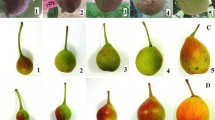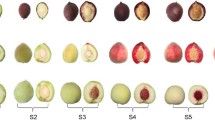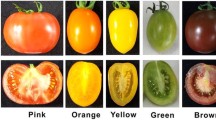Abstract
Mango (Mangiferaindica L.) fruits are generally classified based on peel color into green, yellow, and red types. Mango peel turns from green to yellow or red or retain green colors during ripening. The carotenoids and anthocyanins are the important pigments responsible for the colors of fruits. In the present study, peels of different colored cultivars at three ripening stages were characterized for pigments, colors, and gene expression analysis. The yellow colored cultivar “Arka Anmol” showed higher carotenoid content, wherein β-carotene followed by violaxanthin were the major carotenoid compounds that increased during ripening. The red colored cultivars were characterized with higher anthocyanins with cyanidin-3-O-monoglucosides and peonidin-3-O-glucosides as the major anthocyanins. The gene expression analysis by qRT-PCR showed the higher expression of carotenoid biosynthetic genes viz. lycopene-β-cyclase and violaxanthin-de-epoxidase in yellow colored cv. Arka Anmol, and the expression was found to increase during ripening. However, in red colored cv. “Janardhan Pasand,” there is increased regulation of all anthocyanin biosynthetic genes including transcription factors MYB and basic helix loop. This indicated the regulation of the anthocyanins by these genes in red mango peel. The results showed that the accumulation pattern of particular pigments and higher expression of specific biosynthetic genes in mango peel impart different colors.



Similar content being viewed by others
Abbreviations
- PSY:
-
Phytoene synthase
- PDS:
-
Phytoene desaturase
- ZDS:
-
ζ-carotene desaturase
- bLYC:
-
Lycopene β-cyclase
- BCH:
-
β-carotene hydroxylase
- ZE:
-
Zeaxanthin epoxydase
- VDE:
-
Violaxanthin de-epoxidase
- CHS:
-
Chalcone synthase
- CHI:
-
Chalcone isomerase
- F3H:
-
Flavanone 3-hydroxylase
- F3,5H:
-
Flavonoid 3,5-hydroxylase
- ANS:
-
Anthocyanin synthase
- DFR:
-
Dihydroflavonol-4-reductase
- UFGT:
-
UDP-glucose:flavonoid-O-glycosyl-transferase
- BHLHX:
-
Basic helix loop helix
References
De Candolle, A. P. (1884). Origin of cultivated plants (2nd ed.). London: Hafner Publishing Co..
Mukherjee, S. K. (1951). Origin of mango. Indian J. Genet. Pl. Breed, 11, 49–56.
Steyn, W. J. (2009). Prevalence and function of anthocyanins in fruits. In K. Gould, K. Davis, & W. Chris (Eds.), Anthocyanins: Biosynthesis, functions and applications. USA: Springer Science + business Media, LLC.
Chunxian, C.(2015). Overview of plant pigments. -In Pigments in Fruits and Vegetables Editor: Chunxian Chen ISBN: 978–1–4939-2355-7 (Print) 978–1–4939-2356-4 (Online).
Wang, H., Cao, G., & Prior, R. (1997). Oxygen radical absorbing capacity of anthocyanins. Journal of Agricultural and Food Chemistry, 45, 304–309.
Ichikawa, H., Ichiyanagi, T., Xu, B., Yoshii, Y., Nakajima, M., & Konishi, T. (2001). Antioxidant activity of anthocyanin extract from purple black rice. Journal of Medicinal Food, 4, 211–218.
Medlicott, A., Mohinder, B., & Reynolds, S. (1986). Changes in peel pigmentation during ripening of mango fruit (Mangifera indica var. Tommy Atkins). The Annals of Applied Biology, 109, 651–656.
Chytil, F. (1999). Vitamin A: not for vision only. The British Journal of Nutrition, 82, 161–162.
Ribeiro, D. Q., Fla, V., & Helena, M. (2007). Antioxidant in mango (Mangifera indica L.) pulp. Plant Foods for Human Nutrition, 62, 13–17.
Proctor, J. T. A., & Creasy, L. (1969). The anthocyanin of the mango fruit. Phytochemistry, 8, 2108.
Berardini, N., Fezer, R., Conrad, J., Beifuss, U., Carle, R., & Schieber, A. (2005a). Screening of mango (Mangifera indica L.) cultivars for their contents of flavonol o-and xanthone c-glycosides, anthocyanins and pectin. Journal of Agriculture and Food Chemistry, 53, 1563–1570.
Berardini, N., Knodler, M., Schieber, A., & Carle, R. (2005b). Utilization of mango peels as a source of pectin and polyphenolics. Innovative Food Science and Emerging Technologies, 6, 442–452.
Ruiz-Sola, M. A., & Rodriguez, C. (2012). Carotenoid biosynthesis in Arabidopsis: a colorful pathway. Arabidopsis, 10, e0158.
Sparvolli, F., Martln, C., Sclenza, A., Gavaui, G., & Tonelli, C. (1994). Cloning and molecular analysis of structural genes involved in flavonoid and stilbene biosynthesis in grape (Vitis vinifera L.) Plant Molecular Biology, 24, 743–755.
Kobayashi, S., Ishimaru, M., Ding, C. K., Yakushiji, H., & Goto, N. (2001). Comparison of UDP-glucose:flavonoid 3-O-glucosyltransferase (UFGT) gene sequences between white grapes (Vitisvinifera) and their sports with red skin. Plant Science, 160, 543–550.
Stommel, J. R., Gordon, J. L., Brenda, S. W., & Robert, J. G. (2006). Transcription factor families regulate the anthocyanin biosynthetic pathway in Capsicum annuum. Journal of American Society for Horticultural Science, 134, 244–251.
Honda, C., Kotoda, N., Wada, M., Kondo, S., Kobayashi, S., Soejima, J., Zhang, Z., Tsuda, T., & Moriguchi, T. (2002). Anthocyanin biosynthetic genes are coordinately expressed during red coloration in apple skin. Plant Physiology and Biochemistry, 40, 955–962.
Ban, Y., Chikako, H., Yoshimichi, H., Megumi, I., Hideo, B., & Takaya, M. (2007). Isolation and functional analysis of a MYB transcription factor gene that is a key regulator for the development of red coloration in apple skin. Plant & Cell Physiology, 48, 958–970.
Liu, Y., Xinjie, S., Kai, Z., Yue, B., Xinwei, G., Xiaoming, Z., & Tianhong, L. (2013). Expression analysis of anthocyanin biosynthetic genes in different colored sweet cherries (Prunus avium L.) during fruit development. Journal of Plant Growth Regulation. doi:10.1007/s00344-013-9355-3.
Zan-Wei, Y., Fu-Chu, H., Gui-Bing, H., Xiao-Jing, L., Xu-Ming, H., & Hui-Cong, W. (2011). Differential expression of anthocyanin biosynthetic genes in relation to anthocyanin accumulation in the pericarp of Litchichinensis Sonn. PloS One, 6, 19455e.
Palapol, Y., Saichol, K., Kui, L., Ian, B. F., & Andrew, C. A. (2009). A MYB transcription factor regulates anthocyanin biosynthesis in mangosteen (Garcinia mangostanaL.) fruit during ripening. Planta, 229, 1323–1334.
Hyun, T. K., Lee, S., Rim, Y., Kumar, R., Han, X., Lee, S. Y., Lee, C. H. and Kim, J. Y.2014. De-novo RNA sequencing and metabolite profiling to identify genes involved in anthocyanin biosynthesis in Korean black raspberry (Rubus coreanus Miquel). PLoS ONE. 9.
Busch, M., Anja, S., & Ru, H. (2002). Functional analysis of the early steps of carotenoid biosynthesis in tobacco. Plant Physiology, 128, 439–453.
Ono, N. N., Britton, M. T., Fass, J. N., Nicolet, C. M., Lin, D., & Tian, L. (2011). Exploring the transcriptome, landscape of pomegranate fruit peel for natural product biosynthetic gene and SSR marker discovery. Journal of Integrative Plant Biology, 53, 800–813.
Kato, M., Yoshinori, I. H., Minoru, S., Hiroshi, H., & Masamichi, Y. (2004). Accumulation of carotenoids and expression of carotenoid biosynthetic genes during maturation in citrus fruit. Plant Physiology, 134, 824–837.
Fraser, P. D., Truesdale, M. R., Bird, C. R., Schuch, W., & Bramley, P. M. (1994). Carotenoid biosynthesis during tomato fruit development: evidence for tissue-specific gene expression. Plant Physiology, 105, 405–413.
Smita, S., Rajwanshi, R., Lenka, S. K., Katiyar, A., Chinnusamy, V., & Bansal, K. C. (2013). Expression profile of genes coding for carotenoidbiosynthetic pathway during ripening and their association with accumulation of lycopene in tomato fruits. Journal of Genetics, 92, 3.
Charles, A., Tony, M., Reginald, W., Mirco, M., Roger, P. H., & Andrew, C. A. (2009). The kiwifruit lycopene beta-cyclase plays a significant role in carotenoid accumulation in fruit. Journal of Experimental Botany, 60, 3765–3779.
Cunningham, F. X., Pogson, B., Sun, Z. R., Mcdonald, K. A., & Dellapenna, D. (1996). Functional analysis of the beta and epsilon lycopene cyclase enzymes of arabidopsis reveals a mechanism for control of cyclic carotenoid formation. The Plant Cell, 8, 1613–1626.
Deroles, S. (2009). Anthocyanin biosynthesis in plant cell cultures: a potential source of natural colourants. In K. Gould, K. Davies, & C. Winefield (Eds.), Anthocyanins biosynthesis, functions, and applications (pp. 107–168). New York: Springer Science+Business Media, LLC.
Jaakola, L. (2013). New insights into the regulation of anthocyanin biosynthesis in fruits. Trends in Plant Science, 18.
Azevado-Meleiro, C. and Rodriguez-Amaya, D.(2009) Qualitative and quantitative differences in the carotenoid composition of yellow and red peppers determined by HPLC. -liquid chromatography, liquid Chromatogr. A. 32, 3652–3658.
Shivashankara, K. S., Jalikop, S. H., & Roy, T. K. (2010). Species variability for fruit antioxidant and radical scavenging abilities in mulberry. International Journal of Fruit Science, 10, 355–366.
Vasanthaiah, H. K. N., Kundapura, V. R., Kodthalu, S. S., Lalitha, A., Pappana, N., Gullara, C. M., & Prasad, T. G. (2006). Cloning and characterization of differentially expressed genes of internal breakdown in mango fruit (Mangifera indica). Journal of Plant Physiology, 163, 671–679.
Jain, M., Aashima, N., Akhilesh, K. T., & Jitendra, P. K. (2006). Validation of housekeeping genes as internal control for studying gene expression in rice by quantitative real-time PCR. Biochemical and Biophysical Research Communications., 345, 646–651.
Nambi, V. E., Thangavelb, K., & Manohar, D. J. (2015). Scientific classification of ripening period and development of colour grade chart for Indian mangoes (Mangiferaindica L.) using multivariate cluster analysis. Scientia Horticulturae, 193, 90–98.
Ajila, C. M., Bhat, S. G., & Prasada Rao, U. S. (2007a). Valuable components of raw and ripe peels from two Indian mango varieties. Food Chemistry, 102, 1006–1011.
Huang, Z., Baowu, W., Paul, W., & Ralphenia, D. P. (2009). Identification of anthocyanins in muscadine grapes with HPLC-ESI-MS. LWT - Food Science and Technology, 42, 819–824.
Jia, N., Qing-Yan, S., Dan-Hua, W., Liang-Sheng, W., Zheng-An, L., Hong-Xu, R., Yan-Jun, X., Dai-Ke, T., & Kenneth, M. T. (2008). Identification and characterization of anthocyanins by high-performance liquid chromatography electrospray ionization mass spectrometry in herbaceous peony species. Journal of the American Society Horticultural Science, 133, 418–426.
Montefiori, M., Comeskey, D. J., Wohlers, M., & McGhie, T. K. (2009). Characterization and quantification of anthocyanins in red kiwifruit (Actinidia spp.) Agricultural Food Chemistry. doi:10.1021/jf900800z.
Jean, H. B., & Kevin, H. (2009). Anthocyanin function in vegetative organs. In K. Gould, K. Davis, & W. Chris (Eds.), Anthocyanins: Biosynthesis, functions and applications (pp. 1–12). USA: Springer Science + business Media, LLC.
Gonzalez-Sanjose, M. L., Barron, L. J. R., & Diez, C. (1990). Evolution of anthocyanins during maturation of Tempranillo grape variety (Vitis vinifera) using polynomial regression models. Journal of Science and Food Agriculture, 51, 337–343.
Rivera-Lopez, J., Ordorica-Falomir, C., & Wesche-Ebeling, P. (1999). Changes in anthocyanin concentration in lychee (Litchi chinensis Sonn.) pericarp during maturation. Food Chemistry, 65, 195–200.
Mozetic, B., Trebse, P., Simcic, M., & Hribar, J. (2004). Changes of anthocyanins and hydroxycinnamic acids affecting the skin colour during maturation of sweet cherries (Prunus avium L.) LWT- Food Science and Technology, 37, 123–128.
Kulkarni, A. P., & Aradhya, S. M. (2005). Chemical changes and antioxidant activity in pomegranate arils during fruit development. Food Chemistry, 93, 319–324.
Serrano, M., Guillen, F., Martinez-Romero, D., Castillo, S., & Valero, D. (2005). Chemical constituents and antioxidant activity of sweet cherry at different ripening stages. Journal of Agricultural and Food Chemistry, 53, 2741–2745.
Bureau, S. A., Catherine, M., Renard, A., Maryse, R., Christian, G., & Jean-Marc, A. (2009). Change in anthocyanin concentrations in red apricot fruits during ripening. Food Science and Technol, 42, 372–377.
Usenik, V., Franci, S., & Robert, V. (2009). Anthocyanins and fruit colour in plums (Prunusdomestica L.) during ripening. Food Chemistry, 114, 529–534.
Olaniyi, A. F., & Umezuruike, L. O. (2013). Changes in physical properties, chemical and elemental composition and antioxidant capacity of pomegranate (cv. Ruby) fruit at five maturity stages. Scientia Horticulturae, 150, 37–46.
Romer, S., Lubeck, J., Kauder, F., Steiger, S., Adomat, C., & Sandmann, G. (2002). Genetic engineering of a zeaxanthin-rich potato by antisense inactivation and co-suppression of carotenoid epoxidation. Metabolic Engineering, 4, 263–272.
Zhao, D., Chunhua, Z., & Jun, T. (2011). Carotenoid accumulation and carotenogenic genes expression during two types of persimmon fruit (Diospyroskaki L.) development. Plant Molecular Biology Reporter, 29, 646–654.
Fu, X., Wenbin, K., Gang, P., Jingyi, Z., Muhammad, A., Changjie, X., Don, G., & Kunsong, C. (2012). Plastid structure and carotenogenic gene expression in red- and white-fleshed loquat (Eriobotrya japonica) fruits. Journal of Experimental Botany, 63, 341–354.
Hoang, V. L., David, J. I., Nicholas, S., Gregory, R. M., Michael, J. G., & Ralf, G. D. (2015). Sequence diversity and differential expression of major phenylpropanoidflavonoid biosynthetic genes among three mango cultivars. BMC Genomics, 16, 561. doi:10.1186/s12864-015-1784-x.
Takos, A. M., Robinson, S. P., & Walker, A. R. (2006). Condensed tannin biosynthesis genes are regulated separately from other flavonoibiosynthesis genes in apple fruit skin. Plant Science, 170, 487–499.
Boss, P. K., Davies, C., & Robinson, S. P. (1996). Expression of anthocyanin biosynthesis pathway genes in red and white grapes. Plant Molecular Biology, 32, 565–569.
Gonzalez, A., Zhao, M., Leavitt, J. M., & Lloyd, A. M. (2008). Regulation of the anthocyanin biosynthetic pathway by the TTG1/bHLH/Myb transcriptional complex in Arabidopsis seedlings. The Plant Journal, 53, 814.
Feng, S., Wang, Y., Yang, S., Xu, Y., & Chen, X. (2012). Anthocyanin biosynthesis in pears is regulated by a R2R3-MYB transcription factor PyMYB10. Planta, 232, 245–255.
Pierantoni, L., Luca, D., Paolo, D., Stefano, M., Brenda, S. J., & Winkel, S. (2010). Mapping of an anthocyanin-regulating MYB transcription factor and its expression in red and green pear, Pyrus communis. Plant Physiology and Biochemistry, 48, 1020–1026.
Zhang, X. D., Allan, A. C., Yi, Q., Chen, L. C., Li, K., Shu, Q., & Su, J. (2011). Differential gene expression analysis of Yunnan red pear, Pyrus pyrifolia, during fruit skin coloration. Plant Molecular Biology Reporter, 29, 305–314.
Rahim, M. A., Busatto, N., & Trainotti, L. (2014). Regulation of anthocyanin biosynthesis in peach fruits. Planta, 240, 913–929.
Wang, L. K., Karen, B., Karryn, G., Anne, K., Sakuntala, K., Tony, K. M., Richard, V. E., Roger, P. H., & Andrew, C. A. (2010). An R2R3 MYB transcription factor associated with regulation of the anthocyanin biosynthetic pathway in Rosaceae. BMC Plant Biology, 10, 1471–2229.
Acknowledgements
GK acknowledges University Grants Commission (UGC), New Delhi, for providing financial support in the form of Rajiv Gandhi National Fellowship (RGNF; RGNF-ST-GOA-7140). Authors acknowledge Dr. YTN Reddy (Principal Scientist, ICAR-IIHR, Bengaluru) for providing fruits for this study. KVR and MRD acknowledge the financial assistance from ICAR Network Project on Transgenics in Crops (NPTC): functional genomics of plant type, maturity, and fruit quality traits in mango.
Author information
Authors and Affiliations
Corresponding author
Ethics declarations
Conflict of Interest
The authors declare that they have no conflict of interest.
Electronic Supplementary Material
ESM 1
(DOCX 736 kb)
Rights and permissions
About this article
Cite this article
Karanjalker, G.R., Ravishankar, K., Shivashankara, K. et al. A Study on the Expression of Genes Involved in Carotenoids and Anthocyanins During Ripening in Fruit Peel of Green, Yellow, and Red Colored Mango Cultivars. Appl Biochem Biotechnol 184, 140–154 (2018). https://doi.org/10.1007/s12010-017-2529-x
Received:
Accepted:
Published:
Issue Date:
DOI: https://doi.org/10.1007/s12010-017-2529-x




